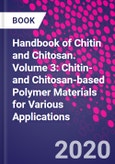The Handbook of Chitin and Chitosan: Chitin and Chitosan Based Polymer Materials for Various Applications, Volume Three, is a must-read for polymer chemists, physicists and engineers interested in the development of ecofriendly micro and nanostructured functional materials based on chitin and their various applications. The book addresses their isolation, preparation and properties and their composites, nanomaterials, manufacturing and characterizations. This is the third of three volumes in a series that contains the latest on the major applications of chitin and chitosan based IPN's, blends, gels, composites and nanocomposites, including environmental remediation, biomedical applications and smart material applications.
Please Note: This is an On Demand product, delivery may take up to 11 working days after payment has been received.
Table of Contents
1. Polymer blends, IPN's, gels, composites and nanocomposite from chitin and chitosan; manufacturing, and applications2. Chemically modified chitin and chitosan as biomaterials
3. Chitin and chitosan-based hybrid nanocomposites for supercapacitors
4. Investigation into the functional properties of cotton, wool and denim textile materials finished with chitosan and the use of chitosan in textile-reinforced composites and medical textiles
5. Chitin blends, IPN's, gels, composites and nanocomposites for adsorption systems: environmental remediation and protein purification
6. Chitin and chitosan based blends, composites and nanocomposite for packaging applications
7. Fundamentals of chitosan for biomedical applications
8. Electrospun chitosan materials and their potential use as scaffolds for bone and cartilage tissue engineering
9. Injectable polymeric gels based on chitosan and chitin for biomedical applications
10. Preparation and application of Biomimetic and bioinspired membranes based on chitosan
11. Chitin, chitosan microgels and nanogels for drug delivery applications
12. Chitin- and chitosan-based Oleogels: Rheological and thermal behavior modifications.
13. Chitosan as biomaterial in drug delivery and tissue engineering
14. Biomedical applications of carboxymethyl chitosan
15. Biomedical exploitation of chitin and chitosan-based matrices via ionic liquid processing
16. Chitin and Chitosan Composites for Bone Tissue Regeneration
17. Drug delivery and tissue engineering applications of chitosan based biomaterial systems
18. Future aspects of biomedical applications of chitin and chitosan in diseases associated with oxidative stress
19. Immunomodulatory activities of chitin and chitosan microparticles
20. Chitosan and chitin-based composites for food packaging applications
21. Modified release properties of gluthathione-based chitosan films: physical and functional characterization
22. Chitosan materials as templates for essential oils
23. Chitosan: A potential biopolymer for wound management
24. Chitin and Chitosan as Promising Immunostimulant for Aquaculture
25. Chitosan based materials for wastewater treatment
Authors
Sabu Thomas Full Professor, International and Inter University Centre for Nanoscience and Nanotechnology, Mahatma Gandhi University, Kottayam, Kerala, India.Professor Sabu Thomas is the Director of Centre for Nanoscience and Nanotechnology, Mahatma Gandhi University, Kottayam, Kerala, India. He is also currently the Chairman of the Trivandrum Engineering Science and Technology Research Park (TrESPARK), Trivandrum, Kerala, India. He was the former Vice Chancellor of Mahatma Gandhi University, Kottayam, Kerala, India. Prof. Thomas is a highly committed teacher and a remarkably active researcher well-known nationally and internationally for his outstanding contributions in polymer science and nanotechnology. He has published over 1400 research articles in international refereed journals. and has also edited and written 210 books. His H-index is 140 and total citations are more than 94,000. He has supervised 125 PhD theses. He has received many international and national awards and recognitions. Under the leadership of Prof. Thomas, Mahatma Gandhi University has been transformed into a top University in India.
Anitha Pius The Gandhigram Rural Institute (Deemed University), Dindigul. Professor Pius achieved her BSc. in Chemistry in 1985 from Holy Cross College, Nagercoil, Madurai Kamaraj University, India following this with and MSc and PhD in Chemistry. Her research interests are environmental chemistry and pollution control, polymer composites, nanocomposites, food chemistry, bioavailability - in vitro studies, photodegradation of pollutants, waste water treatments and anion sensors. Professor Pius is a reviewer for a number of well-known journals including Ecological Engineering, Environmental Monitoring and Assessment, Environmental Science and Pollution Research, Journal of Chemistry & Applied Biochemistry, Journal of Water Process Engineering, National Academy Science Letters and Separation Science and Technology. Sreerag Gopi Co-Founder and Director Molecules Biolabs Private Limited.Dr. Sreerag Gopi is the Co-Founder and Director of Molecules Food solutions Pvt Ltd, Zingon Naturals Pvt Ltd. He was the Chief Scientist at Plant Lipids Pvt Ltd. and Chief Scientific Officer at Aurea Biolabs Pvt Ltd. He served as an adjunct professor at universities including Stockholm University, Sweden, Siberian Federal University, Russia, and Mahatma Gandhi University, India. His doctorate is in organic chemistry and nanotechnology, and nano drug delivery working in the area of natural products, isolation, and biological activities. He's published more than 175 international articles and filed 75+ patents, including in the US and Europe. In his work at Plant Lipids, he developed many innovative products and technologies, and was responsible for driving the research team to excellence, as well as the generation, implementation of new projects, and the presentation of scientific seminars to various customers. He is listed world's top 2% scientist list by Stanford University.








